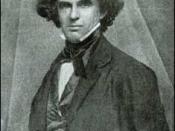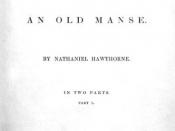Nathaniel Hawthorne's "The Minister's Veil" and "Young Goodman Brown" are very similar in ways of representing spiritual or abstract meaning through material objects or physical actions. They show similar moral effect and storyline that tend to send out some of the same general messages. The characters portray these messages through their thoughts and actions. Their thoughts deeply resemple their "inner life" while actions represent their public life.
"The Minister's Veil" is a story told through the abberation and debauchery of Parson Hooper, a Religious leader. Parson had sinned and wore a black veil over his face in order to metaphorically hide his sin beneath the veil. This action shocked the townspeople and struck curiosity and fear into the hearts and minds of many."I can't really feel as if good Mr. Hooper's face was behind that piece of crepe." (Sexton 2)The story "Young Goodman Brown," is told through the eyes of Gooodman brown who is man who also acted with abberation as a result of his wanting to keep his faith in tact after meeting the devil and having to live in his community in exile.
It could be said that in these stories, both Parson Hooper and Goodman Brown are both wearing a "veil" of guilt in their inner life in order to compensate for or conceal the sins they committed. The "Veil," either physical or metaphorical, develop into strong symbols of guilt and remorse. In regards of this, Parson Hooper and Goodman Brown are men that have committed some form of adultery, sin, or regrettable action that caused them to feel remorseful and respond through public life.
In "The Minister's Veil," Parson commits a sinful act. He uses the black veil to cover his face, symbolically casting shade to the sin. As a priest, he...


